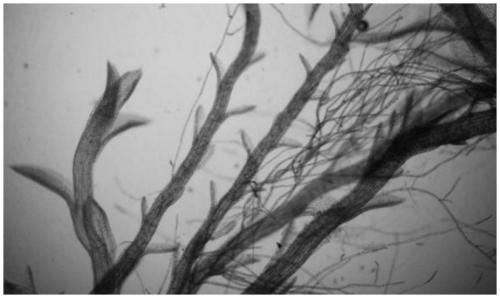A kind of cultivation method of compound crust of moss and desert algae
A cultivation method and technology of moss crust, applied in the field of cultivation of moss and desert algae composite crust, can solve the problems such as difficulty in large-scale production, improve species diversity and viability, accelerate succession process, and improve substrate The effect of conditions and circumstances
- Summary
- Abstract
- Description
- Claims
- Application Information
AI Technical Summary
Problems solved by technology
Method used
Image
Examples
Embodiment 1
[0033] according to figure 1 It can be seen that a method for cultivating the composite crust of moss and desert algae includes the following steps:
[0034] 1. Confirmation of dominant species of moss in desertification areas to be treated 1 and collection and preservation of moss crust 2: According to extensive surveys, identify the dominant species of moss with biological soil crusts in the natural habitat of the area to be restored in summer, and select the well-developed species For moss crusts, collect the surface crusts with a ring knife and air-dry for 10, 13 or 15 days at room temperature for later use.
[0035] 2. Moss crust activity recovery 3: The moss crust activity is restored. The air-dried moss sample is sprayed with water until it is completely wet and incubated for at least 48 hours to restore its activity; the temperature is set to 10 or 12 or 14 or during the activity recovery of the moss sample 15 °C, the light intensity is 5 or 10 or 15 or 20 μmol m -2 s -1 ,...
Embodiment 2
[0049] according to figure 1 It can be seen that a method for cultivating the composite crust of moss and desert algae includes the following steps:
[0050] The investigation found that the moss ( Bryum argenteum ) And the native pair of tooth moss ( Didymodon vinealis ) Widely distributed in Dalat Banner, Inner Mongolia Autonomous Region. Choose two well-developed moss crusts and store them separately after air-drying. The air-dried true moss sample is sprayed with water until it is completely wet, at a temperature of 15 °C and a light intensity of 20 μmol m -2 s -1 , The light-dark cycle is 12 / 12, and the humidity is 80% by incubating for at least 48 hours to restore its activity. After the activity is restored, the moss crust is washed off the sand with distilled water to obtain the moss gametophyte. The gametophyte was washed three times in sterile distilled water. Then disinfect with 5% sodium hypochlorite by mass for 10 seconds, and then rinse with distilled water thr...
Embodiment 3
[0057] The method of culturing the gametophytes of Pterodactylon dentatus is the same as in Example 1.
[0058] Separately cultivate Microcodone sheath and Pseudocladia javanica ( Scytonema javanicum ) To the log phase, the cultivation method is the same as in Example 1 or Example 2.
[0059] Combine the gametophytes of the terrestrial moss, Microcodonia and Pseudocladea javanica in a ratio of 1:5:3 with a dry weight of 1:5:3. After mixing, spray and inoculate on the surface of the sand. The total dry weight of Pseudocladus javanica is 0.9 gm -2 .
[0060] The maintenance of the crust after inoculation is the same as in Example 1 or Example 2.
[0061] One month later, the initial composite crusts of the terrestrial moss, Microcodyle and Pseudocladia javanica can be formed. The crust coverage can reach about 94%, and the coverage of moss can reach 50%-92%.
PUM
 Login to View More
Login to View More Abstract
Description
Claims
Application Information
 Login to View More
Login to View More - R&D
- Intellectual Property
- Life Sciences
- Materials
- Tech Scout
- Unparalleled Data Quality
- Higher Quality Content
- 60% Fewer Hallucinations
Browse by: Latest US Patents, China's latest patents, Technical Efficacy Thesaurus, Application Domain, Technology Topic, Popular Technical Reports.
© 2025 PatSnap. All rights reserved.Legal|Privacy policy|Modern Slavery Act Transparency Statement|Sitemap|About US| Contact US: help@patsnap.com



